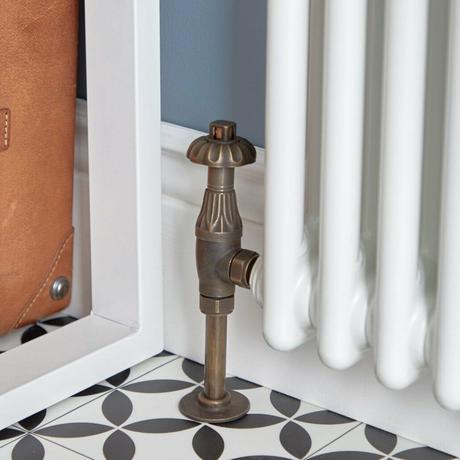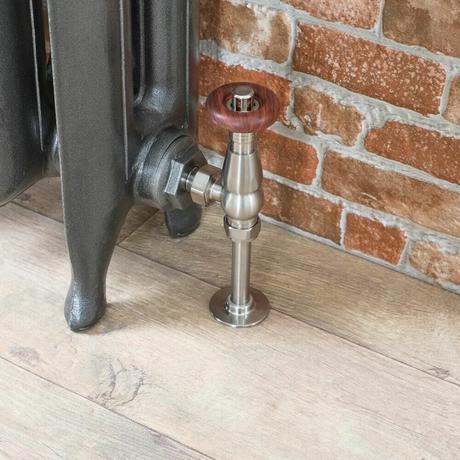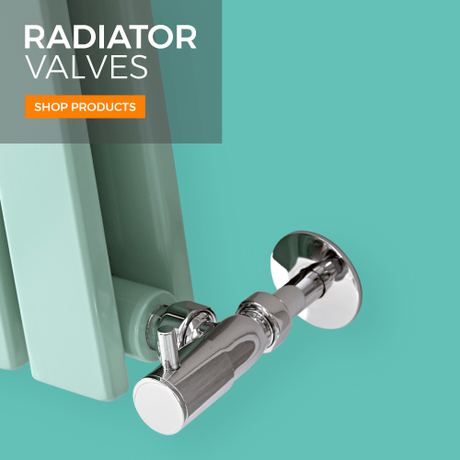Since radiator valves play a significant part in how well central heating radiators operate, and as most of them are visibly on show in our homes, changing your radiator valves is a great way to improve the performance, efficiency and overall look of your heating system.
Most radiators have two radiator valves that connect the radiator to the pipes and allow hot water to enter the radiator and control how much heat is given out.
The lockshield valve is fitted on the return pipe and controls the water flow coming in and out of the radiator. The other valve on the flow pipe is essentially the on/off tap which can either be a manual or thermostatic radiator valve (TRV) with a numbered dial.
Whether you currently have manual or thermostatic valves the process of changing them is the same. So this guide will show you how to change your lockshield radiator valve and either your manual valve or TRV without fully draining the system to get the job done quicker.
But before we start let’s have a look at why you might want to change your radiator valves in the first place!
Why Change Your Radiator Valves?
Why Change Your Radiator Valves?Updating your radiator valves can have many benefits on your home heating and your home decor. Here’s why:
Replacing a faulty radiator valve.
Whether the radiator valve is leaking or stuck in the same position, a faulty radiator valve can cause problems with your whole heating system. So replacing it is a must.
Swapping manual valves for thermostatic radiator valves TRVs
Making the swap to thermostatic radiator valves can help heat your home more efficiently, reduce heating bills and give you more control over the temperature so that each room feels comfortable.
Finding a radiator valve style that suits your home decor
Just like designer radiators have become much better looking over time, there’s now a stylish selection of radiator valves to choose from to suit your home decor.
Even if you’re not ready to get a brand new radiator, just changing the valves is a small detail that can make a big difference to the look of your radiator and complement other accent features in the room.
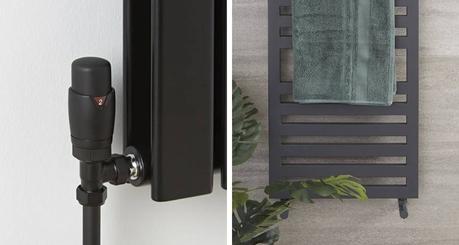
If you consider yourself an experienced DIYer and feel confident with most radiator related jobs then you should find it fairly easy to change a radiator valve if you have a combi boiler system.
However, changing a radiator valve without draining the system is probably not a job for the first-time DIYer so it would be best to get the professionals in.
Also, if you have a conventional system (with a small F&E tank in the loft) we would advise contacting a registered heating engineer as this job will be more difficult.
If you are changing a couple of valves on a few radiators, it is probably best to drain the whole heating system down. If that’s the case, head over to our how to drain a pressurised system guide then come back here to learn how to fit the new valve.
However, if you are only updating one radiator you can change the radiator valve without fully draining the system and there are actually benefits of doing so.
For example, the water in your central heating system is filled with heating additives and inhibitor which protect the system. So draining it fully will mean you are throwing away these important chemicals which you will have to replace to replenish the system.
Since this method of updating radiator valves doesn’t involve changing the pipework, make sure to check that your new radiator valve is an exact match in size to the valve you are replacing.
In this case, the size of the radiator valve refers to the size of the valve connection and pipework instead of the design of the valve.
The standard size of copper pipework is 15mm and all of our radiator valves have a half inch (½”) thread on the bottom (the part that connects the valve to the pipe) which makes them suitable for use with 15mm piping.
So whether you love the large, decorative, traditional valves or the small minimalist options, all our valves have industry standard connections.
But don’t worry if your pipes are slightly bigger or smaller than the standard 15mm. Sometimes copper pipes can be anything between 8mm – 28mm depending on where they are in your home and the age of the building.
So if you find a pair of valves you like the look of but they aren’t the right size for your pipework, you may need to buy radiator reducers or adapters from any plumbing or DIY merchant to ensure a clean connection.
If you’re unsure on the dimensions we would always recommend checking your requirements with your plumber to make sure you have everything you need to change your radiator valve with no issues.
Ready To Change A Radiator Valve?
You will need:
- New radiator valves
- Old towels or sheets
- Adjustable spanner
- Pair of grips
- Wet & dry vacuum or large container
- PTFE tape
- Radiator bleed key
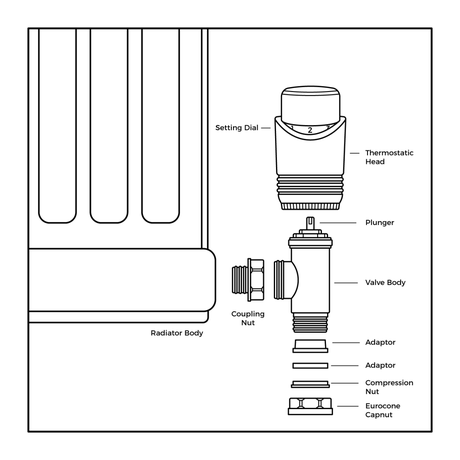
Time needed: 1 hour and 30 minutes.
Follow the steps below to learn how to change your radiator valves.
- Turn the heating and water off
Turn the heating off and allow the radiators to cool completely for at least an hour. You should do this before starting any job to do with your radiators to avoid burning yourself!
Remove the plastic twist cap on the lockshield valve (return valve) and use an adjustable spanner or pair of pliers to turn the spindle clockwise to turn it off until it won’t turn any more. This will stop any water from entering the radiator from that side.
Note down the number of turns it took to turn the lockshield off as you will need to make the same number of turns when you connect the new lockshield and turn it back on.
Then go to the other side of the radiator and turn the valve clockwise by hand until it won’t turn any more. If you have a thermostatic valve, turn it clockwise until the dial reads zero.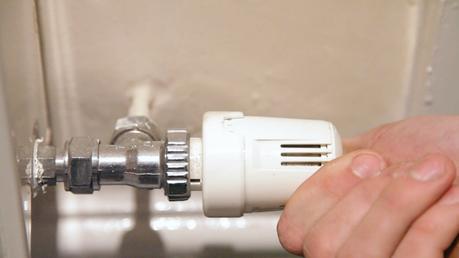
- Protect the floor
Cover the floor area around the radiator under the valves you are going to replace with the towels and container to catch any excess water.
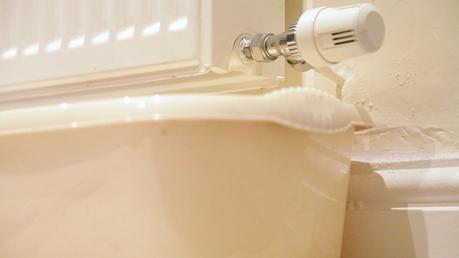
- Prepare the radiator valves
Start this step by preparing your on/off radiator valve on the flow pipe.
If you are swapping an old thermostatic valve for a new TRV, take the thermostatic head off both valves. You should be able to turn this to remove it by hand.
Remove the nuts and adaptors on the new vave and smear the thread that joins to the radiator with the wrap the PTFE tape around clockwise about 8 times to prevent any leaks.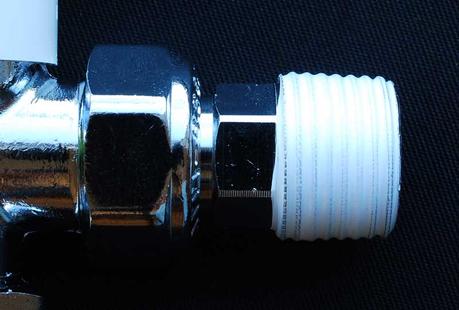
- Release the stored pressure
Take your radiator bleed key and open the radiator bleed valve to release any stored pressure. Then close the bleed valve back up again.
If your lockshield valve has a drain off, you could at this point drain the radiator from the drain valve. Place a container beneath the valve and turn it anti-clockwise to open it using an adjustable spanner.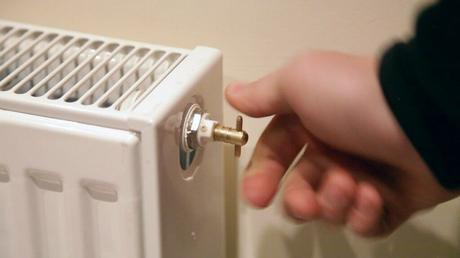
- Open the old valve on the flow pipe
Use a spanner to slacken off the top nut closest to the radiator to open the old thermostatic valve.
To do this, hold the body of the valve with the grips and use an adjustable spanner to make an upwards turn and unscrew the cap nut until water starts to flow out.
It is important to keep hold of the valve body with the grips to avoid it putting pressure on the pipe causing it to bend and potentially leak later on!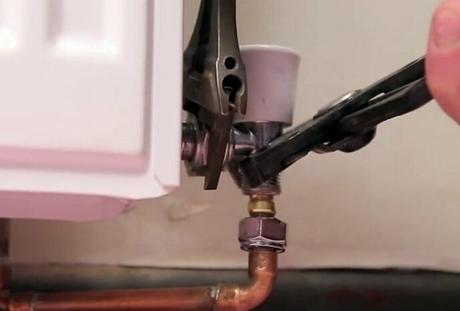
- Release the pressure & drain the radiator.
Once the old thermostatic valve or manual is open, air will escape and water will flow out of the radiator. Use a large container or wet and dry vacuum to catch the water that flows out of the radiator until there is no water left inside. This could take about 5-10 minutes or longer depending on the size of your radiator.
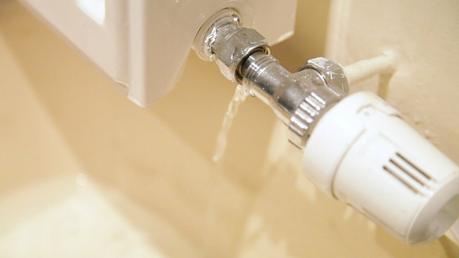
- Remove the old thermostatic valve.
When all the water has drained from the radiator, keep unscrewing the nut until you can pull the valve out of the radiator to disconnect it.
Now use the spanner and grips and turn the nut anticlockwise to loosen the nut on the bottom of the valve that connects to the pipework and remove the valve.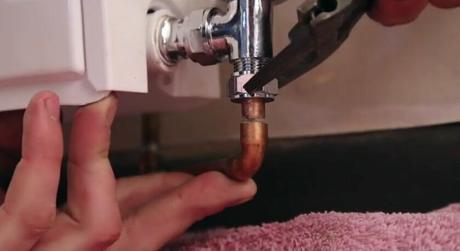
- Attach the new thermostatic valve or manual valve
Holding the valve body with the grips, align it with the adapter and tighten the cap nut with the spanner that holds them together. Then tighten the cap nut that holds the valve to the pipe.
Tighten the nuts by hand for speed then finish off with the adjustable spanner. Make sure it’s not too tight or you might damage the thread!
Then take the new thermostatic valve head and screw it onto the valve. You should be able to do this by hand. - Remove the old lockshield valve
If you are changing both radiator valves so you have a matching pair, now is the time to remove your old lockshield valve.
But if you only want to change your thermostatic or manual valve then you can skip to the final maintenance section.
So, to remove your lockshield valve, use a spanner to slacken off the top nut closest to the radiator like you did in step 5. To do this, hold the body of the valve with the grips and use an adjustable spanner to make an upwards turn and unscrew the cap nut.
Use a container underneath the valve to catch any drips but all of the water should have been drained from the radiator.
Now use the spanner and grips and turn the nut anticlockwise to loosen the nut on the bottom of the lockshield valve that connects to the pipework and disconnect the old valve.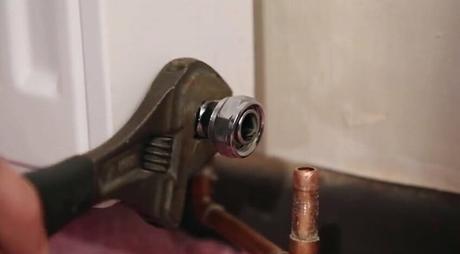
- Connect the new lockshield valve
Repeat step 8 to align the lockshield valve and connect it to the radiator inlet and copper pipe.
Final Maintenance
Your new valves should now be properly connected to the radiator and flow pipe and return pipe. Give yourself a pat on the back, you’ve just changed your radiator valves!
But the job isn’t quite done yet.
There are a couple of things to do after you have changed your radiator valve to make sure that the heating system is working properly.
- Open the valves.
Remember to open the lockshield valve the same number of turns as you noted down to allow water back into the radiator and turn the TRV to your desired number.
Take a look at your new valves and check for any leaks. If you do notice any drips you may need to tighten the nuts.
- Re-pressurise system.
Since the radiator has been drained and refilled you will need to re-pressurise the system to ensure everything is working correctly.
- Bleed the radiator.
Now you need to remove any trapped air inside the radiator. This is called bleeding the radiator. There may also be air trapped in the nearest radiator, so it is best to bleed that one too.
- Check for any leaks.
Finally, take a look at your new valves and check for any leaks. If you do notice any drips you may need to tighten the nuts.
Other Ways To Change A Radiator Valve Without Draining The System
If you think the task of trying to avoid flooding the room whilst changing your radiator valve is too much to handle, there is an alternative method to do the job without draining the system. But, you will need some extra tools to help you.
One method is to use a freezing kit which you can find in any plumbing or DIY store for about £20. This piece of kit will make your life easier by temporarily freezing the flow pipe to prevent water flowing out onto the floor.
You could also grab yourself a radiator draining kit for about £10 to help you change a radiator valve without making a mess. These kits come complete with spillage avoiding essentials like a large container, a sachet of water repellent gel, diverting collar and joining clip.
Finally, if you have any concerns and don’t feel confident changing the valves yourself, you can always rely on a gas safe registered engineer to get the job done for you.
We hope you have found this guide helpful and at this point you have a lovely new pair of valves on your radiator! If you decide you want to change your radiator or need to remove a radiator from the wall for decorating, watch this video to help!
